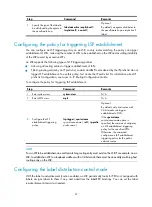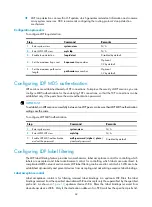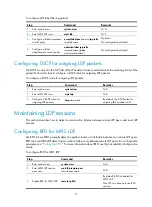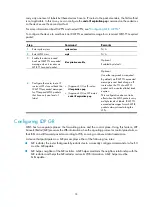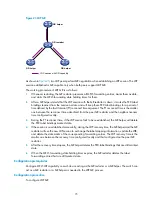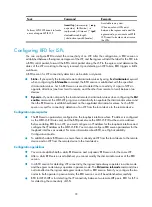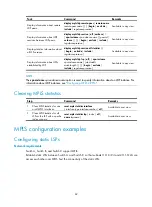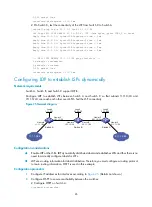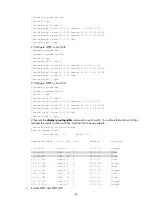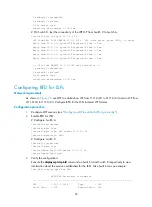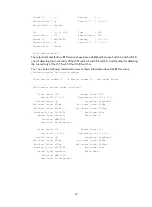
77
•
MPLS LSP tracert
•
BFD for LSPs
•
Periodic LSP tracert
Configuring MPLS LSP ping
MPLS LSP ping is for checking the connectivity of an LSP. At the ingress, it adds the label for the FEC to
be inspected into an MPLS echo request, which then is forwarded along the LSP to the egress. The egress
processes the request packet and returns an MPLS echo reply to the ingress. An MPLS echo reply carrying
a success notification indicates that the LSP is normal, and an MPLS echo reply carrying an error code
indicates that the LSP has failed.
Use the following command to test the connectivity of an LSP:
Task Command
Remarks
Use MPLS LSP ping to check MPLS
LSP connectivity.
ping lsp
[
-a
source-ip
|
-c
count
|
-exp
exp-value
|
-h
ttl-value
|
-m
wait-time
|
-r
reply-mode
|
-s
packet-size
|
-t
time-out
|
-v
]
*
ipv4
dest-addr
mask-length
[
destination-ip-addr-header
]
Available in any view.
When equal-cost LSPs exist
between the ingress node and the
egress mode, you cannot use MPLS
LSP ping to check the MPLS LSP
connectivity.
Configuring MPLS LSP tracert
MPLS LSP tracert is for locating LSP errors. It consecutively sends the MPLS echo requests along the LSP to
be inspected, with the TTL increasing from 1 to a specific value. Then, each hop along the LSP will return
an MPLS echo reply to the ingress due to TTL timeout. So, the ingress can collect information about each
hop along the LSP, so as to locate the failed node. You can also use MPLS LSP tracert to collect the
important information about each hop along the LSP, such as the label allocated.
Configuration prerequisites
•
Enable sending ICMP TTL exceeded messages on the intermediate devices between the source
device and the destination device.
•
Enable sending ICMP destination unreachable messages on the destination device.
•
To display MPLS information during the tracert operation, enable support for ICMP extensions on
the source device and the intermediate devices.
For more information about ICMP time exceeded messages, ICMP destination unreachable messages,
and ICMP extensions for MPLS, see
Layer 3—IP Services Configuration Guide
.
Configuration procedure
Use the following command to locate errors of an LSP:





